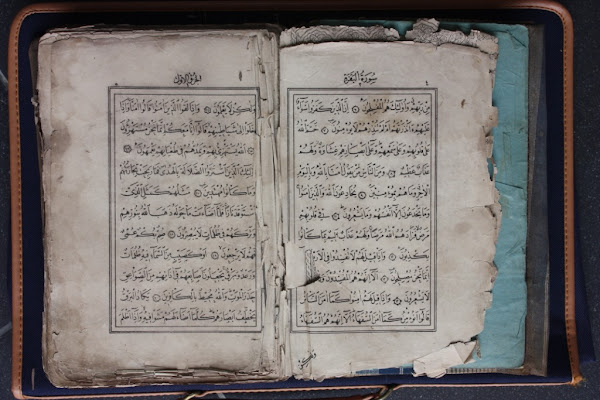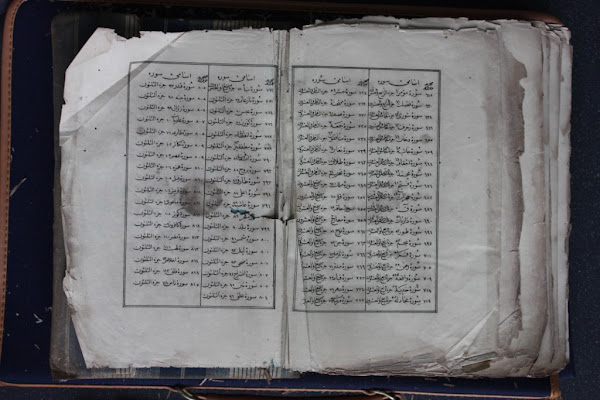Sunday, 23 March 2025
BHO 815
Many maṣāḥif are cross breeds.
UT combines the page layout of HOQz (Haǧǧ Ḥāfiẓ
ʿUṯmān Ḫalīfa QayišZāde an-Nūrī al-Burdurī = Küҫük Hafiz Osman = HO the Younger d. 1894) with the text of KFE2 (1952) without the afterword.
The Ḥaddād-Šamarlī combined the layout of MNQ 522 with the same 1952 text (including the afterword).
KFE1 (1924) crosses many Moroccan features with the eleven/twelve lines of BHO = Bülük Ḥafiẓ Osman = HO the ElderHâfız Osman (1642–1698)
If you say: the KFE has 827 pages, not 815.
you forget that the KFE was type set.
Just as the type set "child" of MNQ522 has 525 pages,
the child of BHO 815 has a few pages more.
Both a scribe and modern (!) IT can modify letter, connection and space between words to copy the page layout exactely,
metall type can not achieve justified lines exactly as in the handwritten "parent".
I critize German orientalists for largely ignoring India, Indonesian, and Africa.
They ignore Central Asia, Iran, Turkey too ‒ even the Levant and Mesopotamia.
They treat Egypt (now: pus Madina) as THE Musim world.
Many believe: the KFE has changed everything for all muslims.
Yes, after 1924 the Amiriyya stopped reprinting maṣāḥif in the Ottoman spelling
and in Egypt, private publisher mostly switched to it too ‒ some kept the old spelling, both as base text with a tafsīr around, and for Qurʾān only.
Some know that in 1951 the ʿIrāqī state published a revisted Ottoman manuscript;
few know that it published another non berKenar muṣḥaf on 689 pages, written by Ḥasan Riḍā
Here together with with it as base text for a Turkish translation
Of course there are expensive facsimiles, reproducing the original faithfully (while maṣāḥif for "lay" Muslims adopted the new standard)
While the berKenar muṣḥaf written by Ḥasan Riḍā were printed in Turkey and his non-berKenar one in ʿIrāq, the 815pp 11liner by Hafiz Osman the Elder was extremely successful in Syria: it was THE muṣḥaf before ʿUṯmān Ṭaha.
As usual there was no title; but: the kolophon was prominent
let's start with images from the first print I came across 1298/1881
Here images by a copy that Muḥammad Hozien acquired because it is the first print that has numbers after each verse (except the first two pages):
another Ottoman example is from 1304/1887
While the prints started in Istanbul, and most were made in Damuscus, the last is from Jerualam/Jodanian al-Quds 1380/
The information page before and the one coming next are not in the "normal" Syrian prints
Unlike the "normal" Syrian prints, the one from 1380 has eliminated most signs (see abvoe the list from al-Quds) because they could confuse ‒ including the ihmal signs (not in the list).
As typical for the time, it has a title page and explanations of the remaining signs:
‒
Subscribe to:
Post Comments (Atom)
Nairīzī
Mirza Aḥmad an-Nairīzī (ca. 1650–1747) is the last of the classical Iranian calligraher s. Informations are hard to find, because often und...

-
40 years ago Adrian Alan Brockett submitted his Ph.D. to the University of St.Andrews: Studies in Two Transmissions of the Qurʾān . Now...
-
There are several types of madd sign in the Qurʾān, in South Asian masāhif: madd al-muttasil for a longer lengthening of the vowel used...
-
Although it is often written that the King Fuʾād Edition fixed a somehow unclear text, and established the reading of Ḥafṣ according to ʿĀ...










































































No comments:
Post a Comment